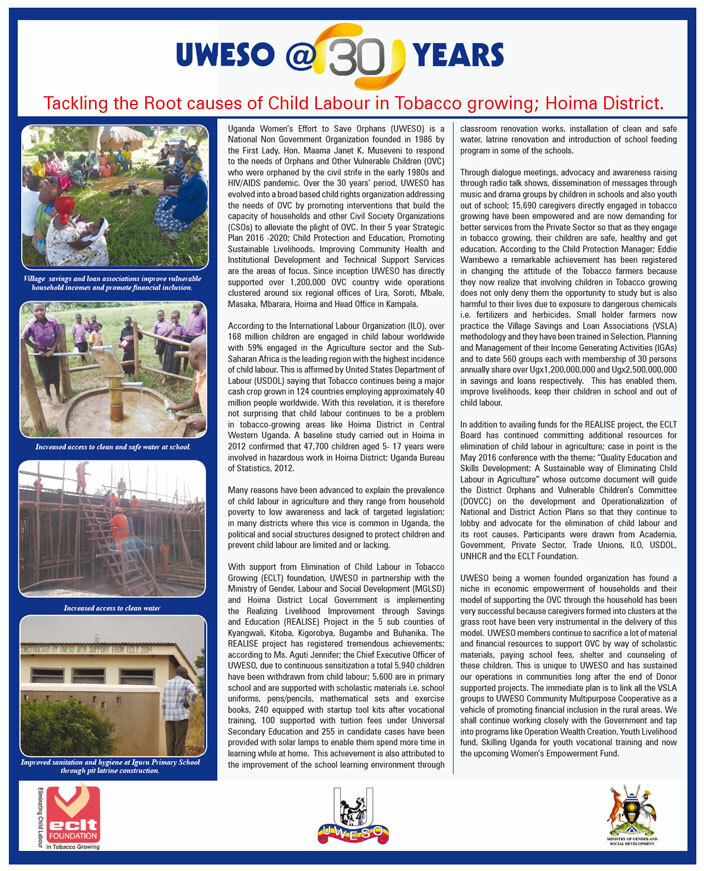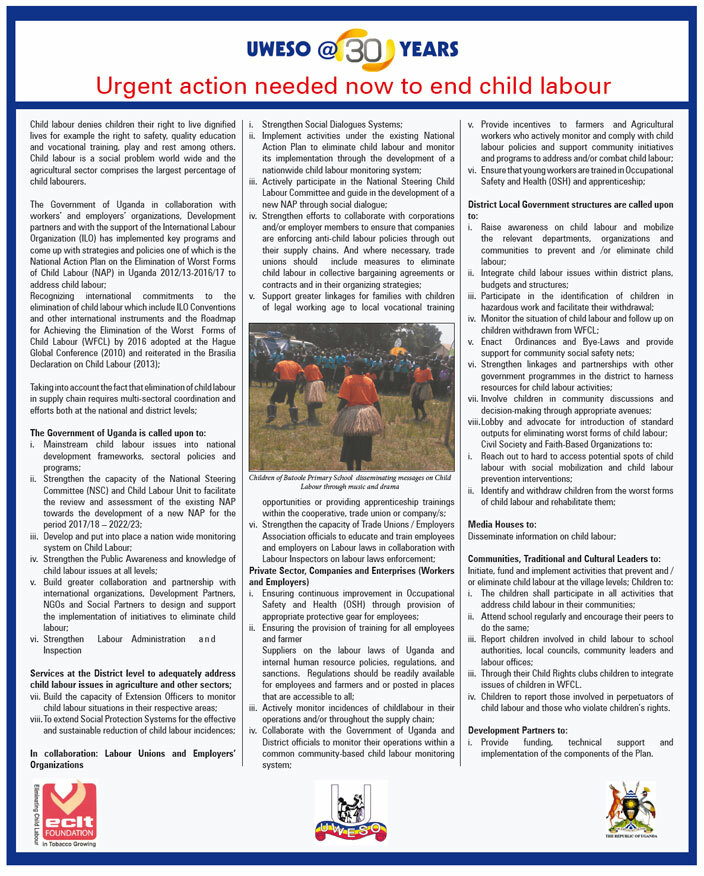UWESO Supplement
Child Labour
Over two million children caught up in child labour
Patrick Okello, the commissioner for labour in the Ministry of Gender, Labour and Social Development, talked to Owen Wagabaza about child labour, its effects, interventions and challenges faced in fighting the vice
What is child labour?
Child labour refers to work that is mentally, physically, socially and morally dangerous and harmful to children. It is that work that interferes with children's school attendance. It is also the hazardous work which by nature or circumstances under which it is performed, jeopardizes the health, safety and morals of children.
What are the different forms?
There are quite many. They include all forms of slavery or practices similar to slavery such as the sale and trafficking of children, debt bondage and serfdom, forced or compulsory labour including forced or compulsory recruitment of children for use in armed conflict.
There is also the use, procurement or offering of a child for illicit activities, in particular for the production and trafficking of drugs, prostitution, or for the production of pornography or for pornographic performances.
What drives child labour in Uganda?
Child labour is caused by several factors, among which is poverty, which compels households and communities to use children for labour. With poverty, children out of necessity, have to work to supplement family incomes and support themselves in school.
There is also the high population growth rate and the HIV/Aids scourge which leaves behind child-headed families. Others are the vulnerability of children, natural hazards, wars and internal conflicts, as well misconceptions on light work.
How worrying is the problem in Uganda?
The problem is really big. In Uganda, children work predominantly in domestic service, stone quarrying, brick making and laying, construction, sand and clay mining. They are also engaged in commercial agriculture, charcoal burning, hotels and bars, hunting and commercial fishing and in the informal sector, petty trading and car washing.
In its worst forms, children are engaged in armed conflict, illegal cross-border trade and trafficking and in child slavery or bonded labour, including forced and abusive marriages. Unfortunately, much of the hazardous work is not always visible to communities.
Families of child workers in dangerous occupations are not aware of its dangers and its effects on their growth, education and development. According to the Uganda National Household Survey Report 2009/10, 2.75 million children aged five to 17 years are engaged in economic activities, of these, 51% are engaged in hazardous work.
Where is it most practised?
It is more rampant in West Nile because of tobacco growing, in the central region around fishing areas, tea plantations and sugarcane growing areas. Stone quarrying areas also have a high incidence of child labour.
It is also concentrated in urban areas where children provide cheap labour for domestic work, in garages, as waiters and waitresses in bars and restaurants, hawkers, trading assistants and many others. It is estimated that 46% of the children working in the informal sector are either underpaid or not paid at all.
What interventions are being undertaken?
Since 1999, the Ministry of Gender, Labour and Social Development, in partnership with ILO-IPEC, the education and local government ministries, the Federation of Uganda Employers, labour unions, Uganda Bureau of Statistics, development partners, civil society organisations, the media, academia and communities, has implemented interventions aimed at the elimination of child labour.
The Government also ratified the International Labour Organisation Convention No. 138 on the minimum age and No.182 on the worst forms of child labour. The government has also put a lot of emphasis on education and vocational training.
Availability, accessibility and quality of education are very important in the elimination of child labour. As a result, the Government has invested heavily in education through programmes like Universal Primary and Secondary Education.
The government is also offering apprenticeship to former child labourers in collaboration with the education ministry under the Business Technical Vocational Education and Training (BTVET) programme.
The Government embarked on strengthening household livelihood through alternative sources of income for the families affected by child labour, so that such families are able to generate income and liberate children from child labour activities. Such programmes include SAGE, the Women Entrepreneurship Programme, Youth Livelihood Programme and many others. We have also intensified advocacy and awareness creation.
What is the progress of the intervention?
Progress has been registered in areas where we have intensified the effort. For example, child labour has immensely gone down especially in Bunyoro region which is a tobacco growing region
What challenges are you facing?
The challenge is that people don't understand what child labour is. They consider it a normal way of life, which is wrong. There is also the issue of attitude. some people feel that eliminating child labour will result into their children becoming indisciplined.
Poverty also remains a big challenge, as well as enforcement of laws. Nonetheless, we are trying our best to see that child labour comes to an end through continuous sensitisation and empowerment of our legal officers to bring to book those behind the vice.
In conclusion...
The Government has put in place a strong legal framework and with this, we are sure that child labour will reduce greatly. We, for example, have the constitution and National Employment Act of 2006 which criminalises the child labour under Section 32.
The children's act forbids employment of children, the prevention of trafficking in persons' act of 2009 and the penal code, which prohibits sexual abuse against children. Conviction against any of these carries a maximum sentence of seven years.
It is on this basis that I call on the public to report all cases of child labour and those promoting the vice so that as government, we can take the necessary measures, including prosecution. As Government, we are committed to ensuring that our children are liberated from child labour and are taken back to school.
It is the responsibility of all Ugandans to ensure that the rights of children are protected and respected.


